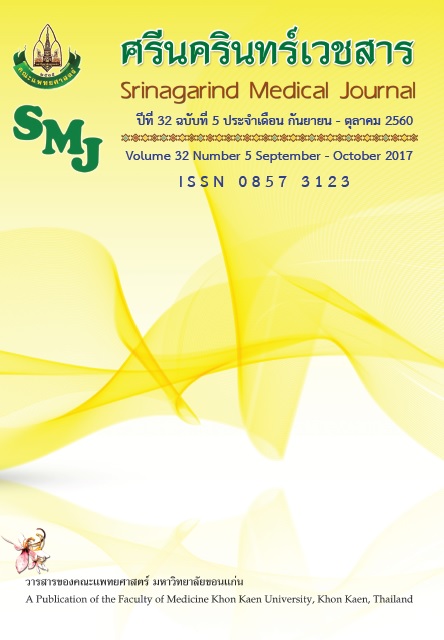Measurements of Eye Lens Doses in Phantom Using Optically Stimulated Luminescence (OSL) Dosimeter
Keywords:
OSL dosimeter, equivalent eye lens doses, phantom, nanoDot, อุปกรณ์วัดปริมาณรังสีโอเอสแอล, ปริมาณรังสีสมมูลประจำตัวบุคคลที่เลนส์ตา, เนื้อเยื่อจำลอง, นาโนดอทAbstract
Background and Objective: Intervention radiology is one of the medical procedure that induce a risk from x-ray ionizing radiation. The risk includes biological effect to eye lens, for example, lens opacities and cataract. The purpose of this study was to measure the eye lens doses in phantom using optically stimulated luminescence(nanoDot). The efficiency of OSL and the calculated personal dose equivalent for eye lens(Hp(3))were simulated and performed using cylindrical phantom.
Methods: OSL nanoDot were placed on the phantom and irradiated with the x-ray energy of 33, 47, and 65 keV. The simulation of eye lens doses of occupational radiation workers in case of wearing and not wearing lead glasses were calculated at the doses of 500, 1000, and 2000 mSv.
Results: The results showed that the accuracy of OSL was 0.11% to 5.84%. The calculated Hp(3) was linearly related to delivered doses(R2 > 0.99). The Hp(3) decreased when the distance between the eye lens and radiation source was increased. With the radiation protection glasses,the occupational radiation dose was reduced from103 to 1012times compare to without lead glasses.
Conclusions: The position and the angle of eye lens against the radiation source and lead absorption energies of X-ray affect to Hp(3). The Hp(3) was significantly reduced when wearing the lead glasses which help to reduce the risk of opacities and cataract.
การวัดปริมาณรังสีสมมูลเลนส์ตาในเนื้อเยื่อจำลองโดยใช้อุปกรณ์วัดปริมาณรังสีโอเอสแอล
อัญมณี ศักดิ์คันธภิญโญ1 ปนัสดา อวิคุณประเสริฐ1* วิทิต ผึ่งกัน2 วราภรณ์ สุดใจ3
1ภาควิชาฟิสิกส์ คณะวิทยาศาสตร์ มหาวิทยาลัยขอนแก่น จ.ขอนแก่น 40002
2กลุ่มมาตรฐานการวัดทางนิวเคลียร์และรังสี สำนักงานปรมาณูเพื่อสันติ กรุงเทพ 10900
3สถาบันเทคโนโลยีนิวเคลียร์แห่งชาติ (องค์การมหาชน) จ.นครนายก 26120
หลักการและวัตถุประสงค์: การใช้รังสีร่วมรักษาเป็นวิธีการที่เพิ่มความเสี่ยงของการเกิดอันตรายต่อดวงตามากขึ้น และเป็นสาเหตุของอาการผิดปกติที่เลนส์ตา เช่น เลนส์ตาขุ่นมัวและต้อกระจก การศึกษานี้มีวัตถุประสงค์เพื่อศึกษาประสิทธิภาพของอุปกรณ์วัดปริมาณรังสีโอเอสแอลชนิดนาโนดอทและการคำนวณค่าปริมาณรังสีสมมูลประจำตัวบุคคลที่เลนส์ตาจากการจำลองสถานการณ์ในเนื้อเยื่อจำลอง
วิธีการศึกษา: ฉายรังสีเอกซ์พลังงาน 33, 47 และ 65 กิโลอิเล็กตรอนโวลต์ด้วยปริมาณรังสี 500, 1000 และ 2000 ไมโครซีเวิร์ต ลงบนอุปกรณ์วัดปริมาณรังสีโอเอสแอลชนิดนาโนดอทที่วางอยู่บนเนื้อเยื่อจำลอง จากนั้น คำนวณค่าปริมาณรังสีและจำลองสถานการณ์การได้รับรังสีของผู้ปฏิบัติงานกรณีสวมใส่และไม่สวมใส่แว่นตาตะกั่ว
ผลการศึกษา:ประสิทธิภาพของอุปกรณ์วัดปริมาณรังสีโอเอสแอลชนิดนาโนดอท มีค่าความคลาดเคลื่อนร้อยละ 0.11 ถึง 5.84 ค่าปริมาณรังสีเฉลี่ยที่ตำแหน่ง 3 มิลลิเมตร มีความสัมพันธ์กับปริมาณรังสีที่อ้างอิงแบบเชิงเส้น (R2>0.99)และลดลงเมื่อระยะห่างระหว่างเลนส์ตาและแหล่งกำเนิดรังสีเพิ่มมากขึ้น เมื่อสวมใส่แว่นตาตะกั่วสามารถลดค่าปริมาณรังสี ได้ถึง 103 – 1012เท่า
สรุป: ตำแหน่งและมุมที่เลนส์ตาทำกับแหล่งกำเนิดรังสี และการดูดกลืนรังสีเอกซ์ของตะกั่วที่พลังงานต่างๆมีผลต่อค่าปริมาณรังสี การสวมใส่แว่นตาตะกั่วช่วยลดปริมาณรังสี ลดโอกาสเสี่ยงต่อการเกิดลนส์ตาขุ่นมัวและต้อกระจกได้อย่างมีนัยสำคัญ (p<0.05)




